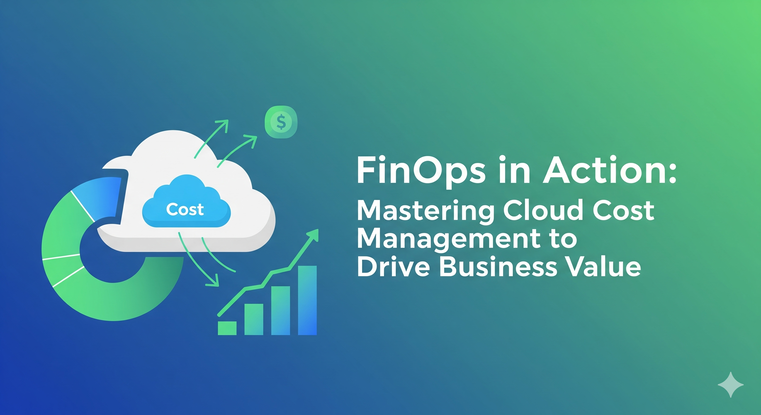
FinOps in Action: Mastering Cloud Cost Management to Drive Business Value
Introduction
In today’s cloud-first world, organizations rely heavily on platforms like AWS, Microsoft Azure, and Google Cloud to scale faster, innovate quicker, and stay competitive. But with flexibility comes complexity—especially when it comes to managing cloud costs.
This is where FinOps (Cloud Financial Operations) steps in. FinOps is not just about reducing costs; it’s about aligning cloud spending with business strategy, ensuring that every dollar spent on the cloud drives measurable value.
In this blog, we’ll explore how FinOps works in action, why it’s essential for businesses in 2025, the best practices, and how mastering it can maximize ROI.
What is FinOps?
FinOps is the practice of bringing together finance, engineering, and business teams to manage cloud costs collaboratively. Unlike traditional cost-cutting methods, FinOps emphasizes efficiency, accountability, and value creation.
-
Finance teams ensure budget control.
-
Engineering teams optimize cloud usage.
-
Business leaders align cloud investment with outcomes.
This cross-functional approach ensures cloud costs are transparent, predictable, and tied to business growth.
Why FinOps is Essential in 2025
With cloud adoption skyrocketing, companies are shifting from “lift-and-shift” strategies to cloud-native architectures. However, Gartner predicts that 80% of businesses overspend on the cloud due to lack of cost visibility.
Key Reasons FinOps is Crucial:-
Rising Cloud Complexity: Multi-cloud and hybrid environments require advanced governance.
-
AI & Data Growth: Generative AI models and big data workloads are compute-heavy, driving up costs.
-
Business Agility: Teams need financial transparency to innovate without financial waste.
-
Regulatory Compliance: Tracking cloud expenses ensures compliance with industry standards.
Core Principles of FinOps
FinOps is built on three major principles:
-
Visibility – Providing real-time insight into cloud spending.
-
Accountability – Ensuring teams take ownership of their cloud costs.
-
Optimization – Continuously improving resource usage and reducing waste.
FinOps in Action: Steps for Cloud Cost Management
Here’s how businesses implement FinOps effectively:
1. Cost Allocation & Tagging-
Assign costs to business units, projects, or teams.
-
Use cloud-native tagging (AWS Cost Explorer, Azure Cost Management).
-
Set cloud budgets aligned with business KPIs.
-
Leverage AI-driven predictive analytics for forecasting.
-
Rightsizing instances.
-
Auto-scaling resources.
-
Using Reserved Instances (RIs) and Savings Plans.
-
Evaluate workload costs across AWS, GCP, and Azure.
-
Use cloud cost management platforms (CloudHealth, Spot.io, Apptio).
-
Conduct regular cost reviews.
-
Establish a Cloud Center of Excellence (CCoE).
-
Train teams in FinOps certifications.
Benefits of FinOps
-
Improved Cost Transparency – No hidden cloud expenses.
-
Enhanced Collaboration – Finance + Tech + Business synergy.
-
Faster Decision-Making – Data-driven financial insights.
-
Increased ROI – Every dollar spent contributes to business value.
Trending FinOps Strategies in 2025
-
AI-Powered FinOps: Machine learning tools automatically optimize costs.
-
Green Cloud FinOps: Sustainable cloud usage that reduces carbon footprint.
-
Serverless & Container Cost Governance: Kubernetes cost optimization is becoming a major priority.
-
FinOps for Generative AI Workloads: Managing GPU-intensive workloads effectively.
Tools & Solutions for FinOps
Some popular tools to streamline FinOps operations:
-
AWS Cost Explorer
-
Azure Cost Management + Billing
-
Google Cloud Billing Reports
-
Apptio Cloudability
-
Kubecost (for Kubernetes environments)
These tools provide dashboards, anomaly detection, and predictive analytics to keep spending under control.
How to Get Started with FinOps
-
Assess Current Cloud Spend – Identify inefficiencies.
-
Set Cloud KPIs – Link spending to business goals.
-
Adopt FinOps Tools – Use automation for optimization.
-
Upskill Your Teams – Train staff with our FinOps course to stay ahead.
-
Create a Governance Framework – Regularly review and refine strategies.
Conclusion
FinOps isn’t just about cutting costs—it’s about maximizing cloud investments to fuel innovation and growth. As cloud adoption continues to scale in 2025, companies that master FinOps will gain a competitive advantage by balancing cost efficiency with business agility.
If you’re looking to upskill and implement FinOps in your organization, check out our FinOps Cloud Cost Management Course designed for professionals and enterprises aiming to drive real business value from the cloud.






